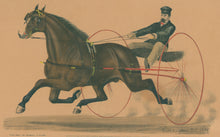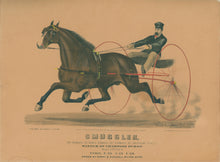Scott Leighton. "Smuggler, By Blanco ... Owned by Henry S. Russell, Milton, Mass."
Boston: Haskell & Allen, 1874. 8 x 13 (Vignette). Lithograph. Original hand color. Paper toned. Else, very good condition.
A Boston lithograph publisher which seems to have issued more large folio images than small folio. Haskell started as picture framer and print seller; listed in 1868 Boston directory as partner in Haskell & Ripley (18 Hanover St.). A year later he formed partnership with George F. Allen. In 1873, Haskell & Allen moved to 61 Hanover St., where they prospered until they went bankrupt in 1878. They had a wide range of prints, including many horse prints.
Popular decorative lithographs made their first American appearance in the 1820s, but by the middle of the century, lithography had transformed the role of art in America. Before the advent of lithography in America, the general public had little art in their lives. Prints intended for display, produced by woodcut or engraving, had a long history, but these prints were generally expensive and limited in distribution to the social elite. Lithography allowed for the production, in large numbers, of inexpensive and often colorful prints which could be purchased by the general public for display in their homes, at work, and in their places of leisure. By the second half of the century, many homes, taverns, shops, and offices were decorated with these cheap and colorful prints on myriad subjects of interest to the public. Whereas at the beginning of the century most Americans had little access to art in their life, by the end of the century, popular art was ubiquitous in the lives of most Americans.





